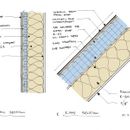Vapor Barrier on This Assembly?
Hello, GBA community,
I am working on a project (architect) in Zone 6 in New York. This is meant to be a simple project from a detail and construction point of view. I am looking to meet the code and make sure the assemblies make sense.
My question is about the use of a vapor retarder in the assembly sown in my sketches. The codes I am considering in NYS Residential Code are: R702.7 Vapor Retarders, R806.5 Unvented … Enclosed Rafter Assemblies and the Energy Conservation Code of NYS R402 Building Thermal Envelope. My conclusion this meets the insulation requirements for Zone 6 Option 1, meets the requirements for condensation control of R-25 above the roof sheathing but does not meet the code requirement of a class 1 or 2 vapor retarder on the interior side of the wall assembly. We could add a membrane like Certanteed or Intello, it would add cost. I would not add a class 1 retarder.
My questions are, is my understanding of the code correct? and does this assembly benefit from a vapor retarder? The Zip R sheathing would keep interior vapor from reaching the OSB portion of the sheathing and vapor entering the cavity would be able to dry to the interior. My understanding is Rockwool is great for absorbing water that could condense and helping to dissipate it.
In case it is hard to see the image here is a link: https://www.dropbox.com/s/f9ibcvcawjewj9o/Wall%20and%20Roof%20Assmeblies.jpeg?dl=0
Thanks for your attention.
Justin
GBA Detail Library
A collection of one thousand construction details organized by climate and house part










Replies
Justin,
Sorry I don't know enough about your code to comment usefully.
Just a note: Rockwool is hydrophobic. It neither absorbs nor redistributes moisture. Cellulose has those properties.
> Zip R sheathing would keep interior vapor from reaching the OSB portion of the sheathing
What data supports this?
Better to use plywood with unfaced EPS "over" the wall (as code is written).